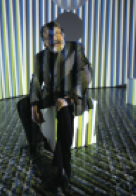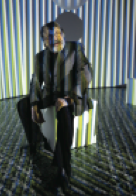The Museum of Fine Art, Houston
Presents First Large-Scale Retrospective of Carlos Cruz-Diez
Carlos Cruz-Diez: Color in Space and Time features more than 150 works from the artist’s wide-ranging career, selected from the Cruz-Diez Foundation Collection at the MFAH, and from major private and public collections around the world. For more than five decades Carlos Cruz- Diez (b. 1923) has intensively experimented with the origins and optical phenomena of color. His wide-ranging body of work includes unconventional color structures, light environments, street interventions, architectural integration projects and experimental works that engage the response of the human eye while insisting on the participatory nature of color.

The Museum of Fine Arts, Houston, and the Cruz-Diez Foundation, Houston present the first large-scale retrospective of this pioneering Venezuelan artist who has also adopted the French nationality after having lived in Paris for the most part of his life. Carlos Cruz-Diez. Color in Space and Time will feature more than 150 works created from the 1940s to today, including paintings, silk-screen prints and innovative chromatic structures; room-size chromatic environments, architectural models and videos; and a virtual re-creation of the artist’s studio. The exhibition introduces international audiences to Cruz-Diez’s extensive production and is placing his theoretical and artistic contributions to 20th-century Modernism in a broader context than they have traditionally been seen.
Cruz-Diez have made several appearances in Houston, teaching a seminar at the Glassell School of Art and participating in a lec- ture, Conversing with Color: Carlos Cruz-Diez and Mari Carmen Ramírez, that took place during the first week of February.
The starting point for Cruz-Diez’s chromatic investigations is the unstable nature of color. In his view, color is not a pigment on a solid surface but a “situation” that results from the projection of light on objects and the way this light is processed by the human eye. Insofar as color depends on the movement of the viewer in front of the work, it entails a participatory and interactive experi- ence in space and time.The artist’s task is to induce “situations” and to stimulate the dialogue between the stable and the unstable nature of color on a variety of supports by means of multiple strategies and unconventional materials that included cardboard, aluminum, polished stainless steel and acrylic paint.
Accompanied by a major catalogue, Carlos Cruz-Diez: Color in Space and Time is curated by Mari Carmen Ramírez, Wortham Curator of Latin American Art and Director, International Center for the Arts of the Americas at the MFAH. “Carlos Cruz-Diez: Color in Space and Time celebrates Cruz-Diez’s groundbreaking achievements with color, presenting him as one of the most remarkable, pioneering artists of the late 20th century,” said Peter C. Marzio, MFAH director.
“Generally considered in the context of Kinetic Art, the significance of the large body of work produced by Cruz-Diez since the 1950s extends beyond issues of movement, vibration and sheer retinality. From the beginning, Cruz-Diez focused his research and experiments on one critical issue: the investigation of color as a living organism that is in a constant state of trans- formation. This exhibition aims to show his radical and unprecedented achievements in this area,” said Ramírez.
Cruz-Diez’s work combines color theory, science, kinetics, mechanical engineering and the painter’s craft and defies easy categorization. In order to realize his artistic vision, particularly- with regard to the innovative Physichromies series, the artist adapted or invented his own tools and machines. And he has involved his family and a large corps of assistants in the enter- prise, with guild-style studios in Paris, Panama, and Caracas. The works on view in Carlos Cruz-Diez: Color in Space and Time will be culled from the Cruz-Diez Foundation Collection at the MFAH and the Atelier Cruz-Diez in Paris and Panama; as well as public and private collections in the United States, Venezuela, France, England, Germany, Italy, and Spain.





